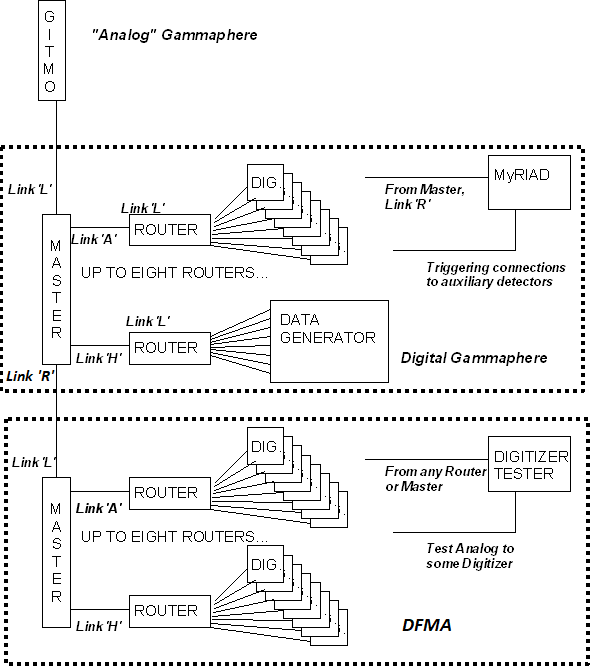Linking Systems Together: Difference between revisions
Jump to navigation
Jump to search
| Line 7: | Line 7: | ||
The basic method of clock sharing that most users are familiar with is that the master trigger sends clock to the routers, and the routers re-distribute that clock to the digitizers. Many users also understand that this tree of clock distribution has been extended to include Digital Gammasphere (DGS) sending the clock to DFMA, as shown here. | The basic method of clock sharing that most users are familiar with is that the master trigger sends clock to the routers, and the routers re-distribute that clock to the digitizers. Many users also understand that this tree of clock distribution has been extended to include Digital Gammasphere (DGS) sending the clock to DFMA, as shown here. | ||
[[File:ClockHierarchy.png | [[File:ClockHierarchy.png|Standard clock distribution]] | ||
Those that have been involved from the beginning will recall that the DGS master trigger could also be connected to 'Analog' Gammasphere using the GITMO module - and use the clock from 'Analog' Gammasphere. Those that have been involved with hosting external detectors such as CHICO, Microball, ORRUBA, etc. also understand that there is clock sharing associated with the MyRIAD module. A more full picture of this clock distribution hierarchy is shown here. | Those that have been involved from the beginning will recall that the DGS master trigger could also be connected to 'Analog' Gammasphere using the GITMO module - and use the clock from 'Analog' Gammasphere. Those that have been involved with hosting external detectors such as CHICO, Microball, ORRUBA, etc. also understand that there is clock sharing associated with the MyRIAD module. A more full picture of this clock distribution hierarchy is shown here. | ||
Revision as of 17:05, September 11, 2019
Linking Multiple Systems Together
The trigger logic implemented for the various DAQ systems and the hardware design of the trigger module allows for the possibility to link multiple systems together. This allows both clock synchronization and trigger sharing to occur. A number of rules must be obeyed, so read carefully.
Clock Sharing
The basic method of clock sharing that most users are familiar with is that the master trigger sends clock to the routers, and the routers re-distribute that clock to the digitizers. Many users also understand that this tree of clock distribution has been extended to include Digital Gammasphere (DGS) sending the clock to DFMA, as shown here.
Those that have been involved from the beginning will recall that the DGS master trigger could also be connected to 'Analog' Gammasphere using the GITMO module - and use the clock from 'Analog' Gammasphere. Those that have been involved with hosting external detectors such as CHICO, Microball, ORRUBA, etc. also understand that there is clock sharing associated with the MyRIAD module. A more full picture of this clock distribution hierarchy is shown here.
